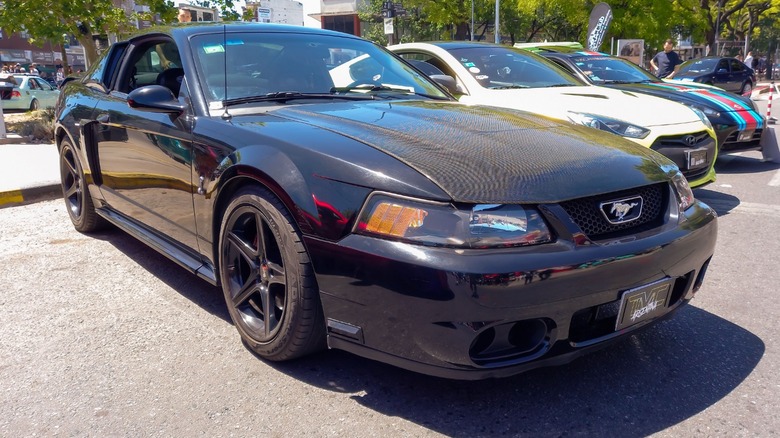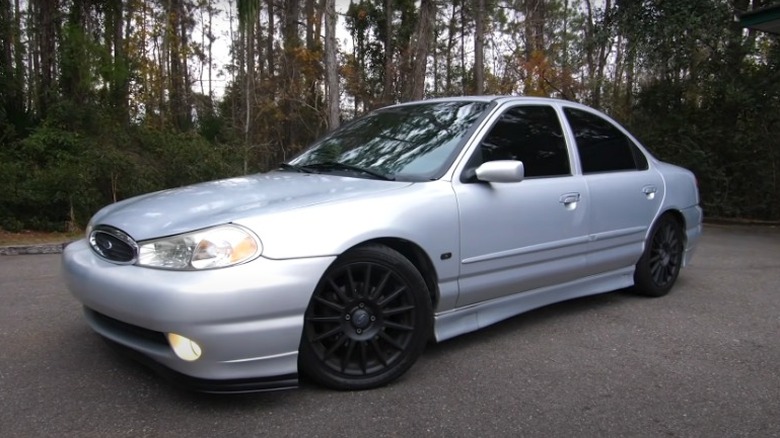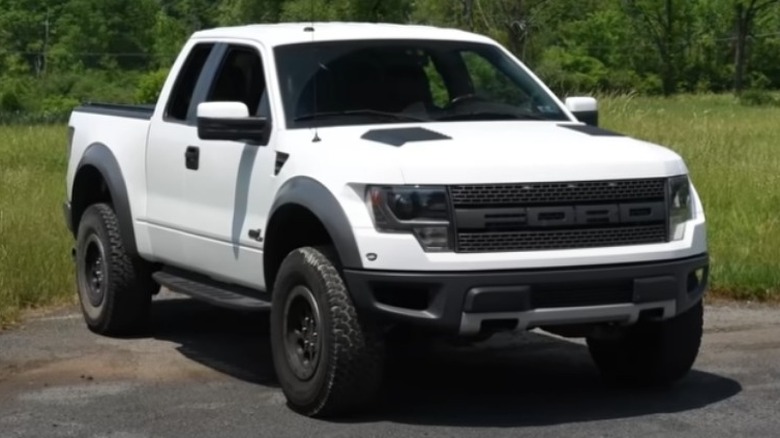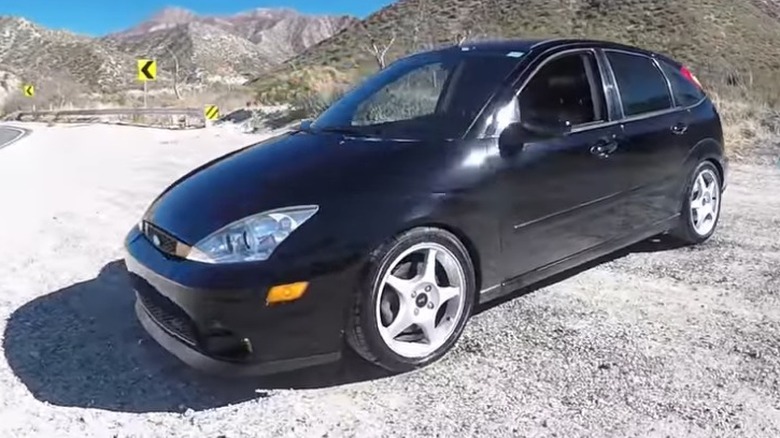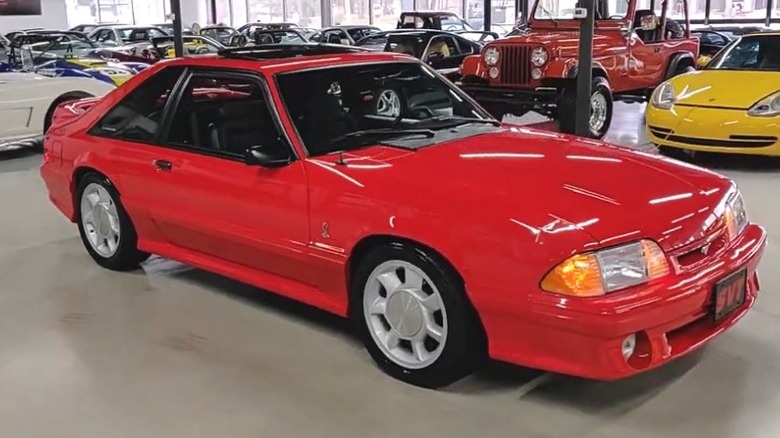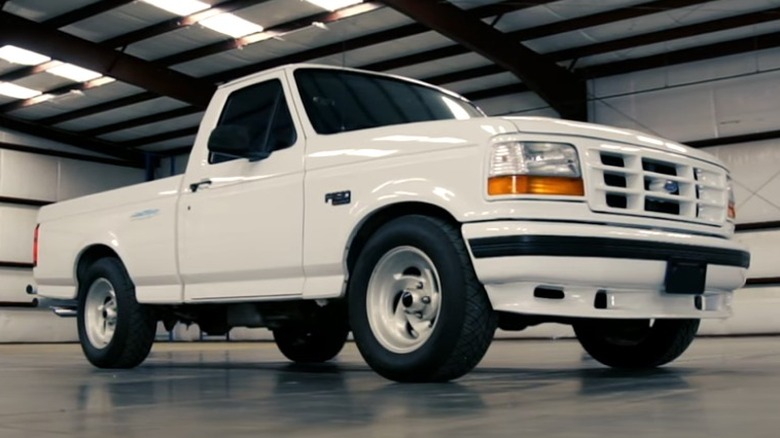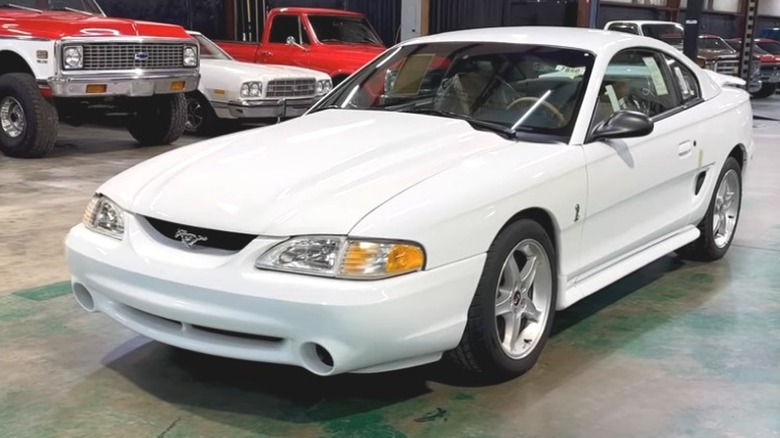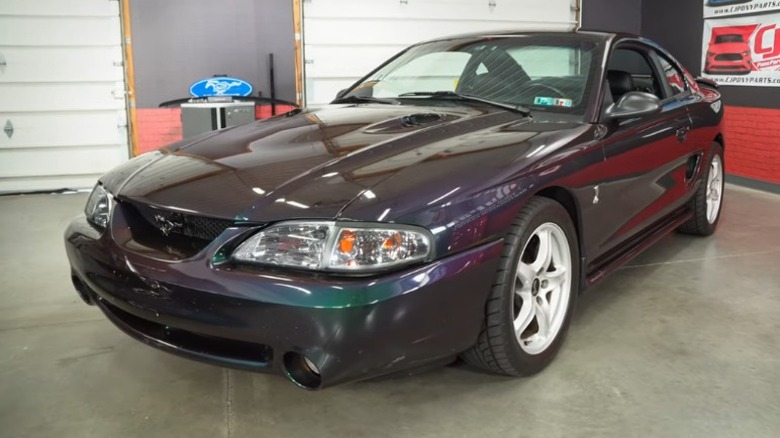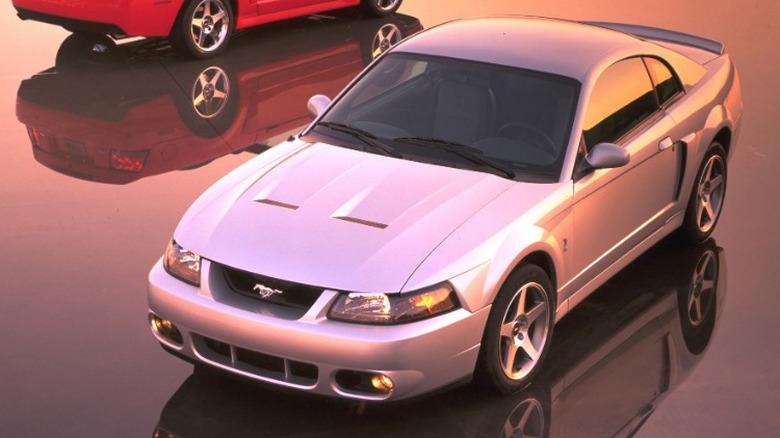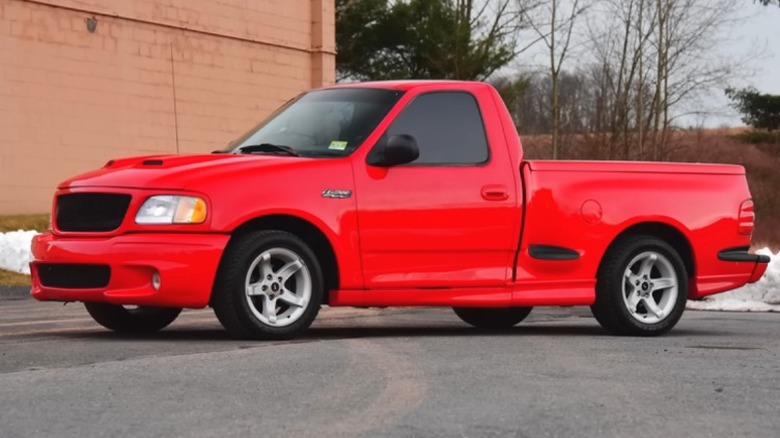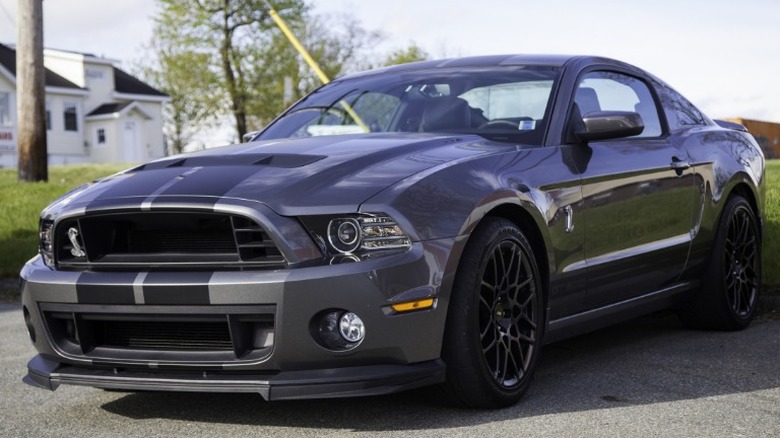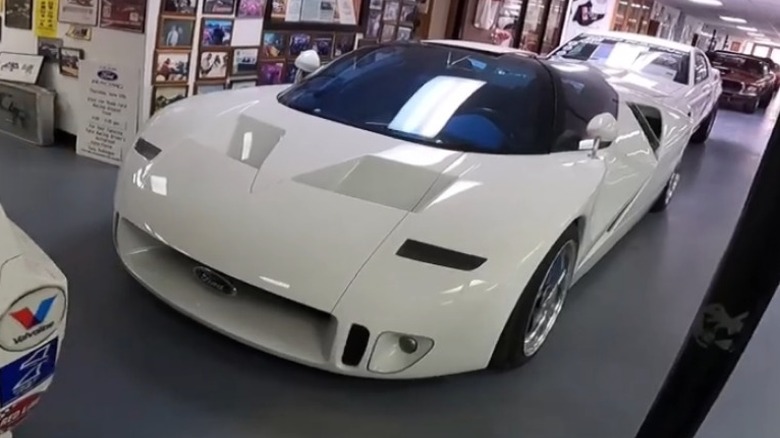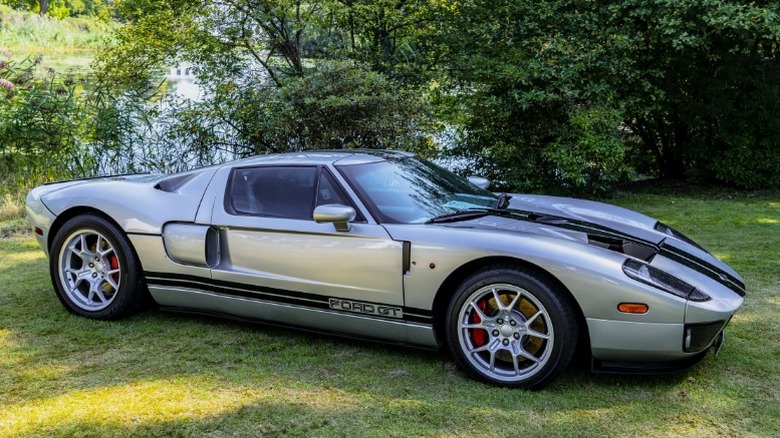All Of The Best Ford SVT Cars And Trucks, Ranked
Ford's Special Vehicle Teams (SVT) grew out of the original Special Vehicle Operations that had, in the '80s, developed and released the Mustang SVO, a potent turbo 4-cylinder pony car that threatened even the Mustang GT by making a more powerful engine than its 5.0-liter V8. While the SVO had been wound down already, Ford created in 1991 the new SVT division to develop special edition vehicles that could showcase the performance aptitude of select models, beginning with the Mustang.
The official launch of SVT happened in 1992 during the Chicago Auto Show, where Ford debuted both the 1993 SVT Mustang Cobra and SVT F-150 Lightning. For Ford, SVT would continue to be a promotional tool throughout its run as the hype surrounding these high-performance models could be used as aspirational models to get buyers in the doors of dealers. SVT continued to modify and release special edition models through 2014. Ford then combined SVT with Ford Team RS of Europe, Ford Performance Vehicles of Australia, and Ford Racing into one blanket organization for all high-performance factory Ford projects called Ford Performance. This is the division responsible for all high-performance products from Ford today. As the successor to the modern Ford Performance, SVT created some excellent special editions of Ford cars, and here are the best of them ranked from the good ones to the best.
1998-2000 SVT Contour
Ford of Europe has long marketed a different pack of vehicles from what it offers on Ford's home turf. Occasionally one of these comes back across the pond, including the 1978 Ford Fiesta and Mercury Capri as well as the disastrous Merkur debacle of the late '80s. In the late '90s, Ford's most standard family car in Europe was called Modeo and it would be brought back to the States as the Contour. It did not end up being the most successful model, but it allowed SVT an opportunity to try its hand at a front-wheel-drive car.
SVT had a tall order making the Contour an exciting car. With its stock form, drivers received a 170-horsepower 2.5-liter V6 mated to a 5-speed transmission or an automatic. Handling existed and the rest of the car had styling. It wasn't any particular styling, but it did have styling. SVT managed to get the power rating up to 200 and modified the suspension to give it some grip. This came with some side skirts and modified front and rear bumpers along with special leather interiors to give it an overall sporty feel.
Considering the base model the company was working with, the SVT Contour is uniquely impressive. The final project, while never great, was significantly better than it had been from the start. Only about 12,000 units were sold in three years and it's tough to find one for sale without a dedicated search.
2010–2014 Ford F-150 SVT Raptor
While the Ford Raptor pickup is a popular model today, it started as a project under SVT and the first model came out in 2010. This truck would also be the final SVT product to be released before SVT was rolled into the overarching Ford Performance division.
Unlike the previous Lightning trucks modified for high-performance street driving, the Raptor is an off-road beast. The 2010 model debuted a new 6.2-liter V8 engine and pushed the power output up to 411 horsepower with 434 lb-ft of torque. The immense power is, of course, sent through all four wheels through an electronically controlled transfer case, and the suspension is lifted and ready for heavy trail driving action. With the beefed-up suspension comes more electronic goodies in the traction control that help keep the truck planted while still allowing for the driver to get into some pretty hairy situations just for fun.
While this model of Raptor ended in 2014, along with SVT, it continues under the Ford Performance name. Power has been steadily increasing and capabilities along with it. But SVT was responsible for the first dedicated performance Ford trucks and those models will forever be worth saving, including the Raptor.
2002-2004 SVT Focus
One category the Europeans have always dominated is that of the hot hatch. With entries such as the VW GTI, Peugeot 205 GTi, Renault R5, and more, the Americans had some catching up to do, although the Shelby GLHS was a worthy entrant into the competition. With the new Focus debuting in the States and in Europe, SVT chose to warm one over for a home-grown hot hatch done the Detroit way.
Although the Focus would not truly be a single international platform until 2012, the basics were all there. The SVT model used Focus hatchbacks in three or five-door versions receiving significant upgrades to the engines and suspensions. The 2.0-liter engines were upgraded throughout with better heads, pistons, cams, and more such that the final product created up to 170 horsepower, an increase of 40 horses over stock. They were further equipped with roll bars, stiffer springs, and re-tuned shocks to offer better control through corners.
While the Focus would never be competition to a Cobra, it made its mark by being a sporty compact with attractive styling competitive with similar cars of its day. They were affordable little road racers and can be a bit hard to find today as only about 3,000 copies were sold. However, excellent condition examples can be found on Bring a Trailer for around $10,000.
1993 Mustang SVT Cobra
While the Cobra name had been applied sporadically to Ford products throughout the '60s and '70s, its use had waned by the end of the early '90s. When SVT chose it for its first rendition of a high-performance pony car, it also signified the return of power as automakers had finally figured out ways to make powerful engines that could also pass emissions testing.
While these figures are modest, if not paltry, by today's standards, the 235-horsepower V8 in the 1993 SVT Cobra that pushed the car to 609 mph in 5.9 seconds was the first glimmer of hope for those who desired fast-driving cars straight from the factory. Not only were these Mustangs more powerful than other production models, but they also received upgraded suspensions that provided even better cornering. Regardless, these Cobras were perfect for modifying and many, if not most, of them were fitted with an array of high-performance add-ons that could easily boost power on the robust Ford 5.0-liter V8 block.
The SVT Cobra of 1993 was also a sort of swan song for the Fox Body as the next model year would see an all-new body style come out, ending a 14-year run of a now-beloved car. 1993 Cobras are highly collectible today, and the limited production run of about 5,000 units means rarity keeps values high. An SVT Cobra R, the stripped-down racer version of which SVT produced just over 100 copies, recently sold at auction for $132,000.
1993-1995 Ford SVT Lightning
With the inaugural SVT Cobra in 1993 came the first-ever Ford high-performance truck model, the F-150 SVT Lightning. Outfitted with a similarly improved and modified V8 as the Mustang, the Lightning received a 351 Windsor engine from the F-250 backed up by a heavy-duty transmission. In this guise, the F-150 came from the factory with 240 horsepower, a 20% increase from standard heavy-duty trucks of the day. The Lightning was equipped with a modified intake, tubular exhaust manifold, and upgraded cylinder heads.
The Lightning was notable for its improved performance but also stood out with a paint scheme that eliminated chrome from the bumpers and trim in favor of red paint and black trim. It also rode on custom wheels and featured a tuned suspension that gave it flat cornering and a lower stance than stock F-150 models. It did not sell in particularly high numbers when new but has since become an icon and a highly desirable model of Ford truck fans everywhere, including one owned and driven by Lady Gaga.
1995 SVT Cobra R
After the inaugural model came out in 1993, SVT continued producing high-performance cars for the newly revised Mustang with its 1994 model year. But in 1995, SVT released just 250 copies of the Mustang Cobra R and sold all of them in less than a week.
This particular car was destined to be a track day model from the start, and its 351-cubic-inch V8 shared with the SVT Lightning truck was tuned up to crank another 60 horsepower up to a total of 300 horsepower and torque sent to 365 lb-ft. The car was sold with everything needed to make it street-legal but without any warranty except for what was federally required on the emissions-related equipment. Other updates made by SVT include making the hood from fiberglass, adding adjustable Koni shocks, an engine oil cooler, a power steering cooler, and an upgraded radiator. The Cobra R has a taller cowl on the hood to make room for the revised intake and all of these models were sold in white paint.
Today, this is perhaps the most special of all the Mustangs from the '90s and one of the rarest. If you are in the market for one of the 250 copies produced, expect to have around $50,000 at the ready.
1996-1998 SVT Cobra
With the 1996 model year Mustang, SVT would have the chance to see what its team could do with the new Modular 4.6-liter V8 developed by Ford. This engine was a significant departure from the previous engine as it changed from being an overhead valve engine to an overhead cam engine, a first for mass-produced American V8 engines. This gave SVT the chance to double the number of valves by making the heads accommodate dual cams on each bank of cylinders. As a result, the SVT Cobra could raise the 215 horsepower of a Mustang GT to 305 for the Cobra, which was also a full 65 horsepower more than the previous model.
With the 1996 model, horsepower over 300 was no longer restricted to cars built expressly for track use. Everyday drivers could be used on the streets and opened up at will while continuing to enjoy the creature comforts of a modern car. These Cobras today are just now heading upward on the appreciation curve and anyone who bought one five to seven years ago is likely to see a jump in the value of their cars. Sales history from Bring a Trailer shows that five years ago, these sold within the $5,000 to $15,000 range and today the low end is closer to $20,000 and often much higher.
2003-2004 Terminator SVT Mustang Cobra
SVT followed up the 1996 Cobra a few years later, increasing horsepower to 320 in 1999, but failed to widely please fans with this model. Rumors persisted that it was overrated and failures on the track helped to perpetuate them. 5,300 Cobras would eventually be recalled for a faulty muffler and intake manifold that resulted in a reduction of 50 horsepower. To ensure SVT would not have a repeat experience, the 2003 Terminator SVT Cobra was released with a new positive displacement inter-cooled supercharger that boosted the 4.6 Modular V8 to a healthy 390 horsepower. With this car, SVT had a genuine tire shredder on its hands and the public responded enthusiastically.
The Terminator Cobras were also offered with a $3,650 paint option called Mystichrome. The paint had added aluminum that made the color change from blue to purple to green and even appear black sometimes, depending on the angle and lighting. This car signaled the end of the line for this body style as 2005 would be the introduction of the new retro-styled Mustangs.
1999-2004 Ford SVT Lightning
The first SVT Lightning was a success in accomplishment if not by sales figures. It showed that the concept of a high-performance truck built for the street could work, so the team revisited the idea for another bolt of lightning to strike before the millennium ended.
Using an updated F-150 with its sculpted design and softer lines, SVT installed a supercharger onto the new 3-valve 5.4-liter Triton engines making them good for 360 horsepower until the 3-valve version with variable valve timing came out in 2001 and bumped it up to 380. While the idea of a high-performance truck for the street is a bit ridiculous, the Lightning makes a pretty good case for itself. 60 mph is attained in less than six seconds and uninformed participants at midnight drags could have their cars easily embarrassed by these quick cargo haulers. The public was warm to the idea also. More than 13,000 models were solid in its first year, and with another five years of production, there are plenty left today if you need a solid and reliable truck that also happens to be fun and fast.
2007-2009 SVT/Shelby GT500
After a hiatus of many years, Ford brought the Shelby name back affixed to its all-new retro-styled fifth-generation Mustang. In the early days of the Mustang, Carroll Shelby created special edition Mustangs for lovers of high-speed driving. The Shelby name then became synonymous with fast and powerful cars, which is what this Mustang would ultimately be.
SVT worked with Shelby American to create a uniquely powerful Mustang that would honor the Shelbys of the past. The 2007 GT500 Super Snake received a 32-valve 5.4-liter V8 engine equipped with an Eaton supercharger good for 500 horsepower. Brembo brakes, special aluminum wheels, and a sport-tuned suspension filled out the package along with styling flourishes throughout to signify these cars as something very different from a regular Mustang GT.
Sales of the Super Snake reached nearly 23,000 during its three-year run, despite its retail price of more than $40,000. Shelby American also offers upgrades for this car including a wide body package, performance clutch, forged wheels, and, for an additional $75,995, an engine upgrade to 1000 horsepower. Although it is a more recent SVT car, it is one worth having.
1995 Ford GT90
Ford produced the iconic GT40 race car to beat Ferrari at LeMans in the 1960s, making Ford a hometown hero in Detroit. It launched a racing legacy that waned in the following years, leaving fans clamoring for a follow-up to the wildly successful Ferrari killer. A second act would come in the '90s under the direction of SVT's top managers.
In 1995, Ford revealed a stunning creation in a mid-engine supercar to rival anything coming from Modena or Stuttgart. Taking the chassis and suspension from the Jaguar XZ220, which Ford opened at the time, engineers added unique body panels and glass before installing a 4.0-liter V12 fabricated from existing parts and tuned by Roush. The final product produced an astonishing 720 horsepower, at the extreme in terms of power output of the day. Even the most powerful contemporary supercars were only just breaking 500 horsepower at the time, and even the incredible McLaren F1 registered at 618.
This incredible machine was called the GT90, but there would only ever be one. It was a concept from the start and never considered for regular production, a shame considering its stunning good looks and massively impressive performance. In the end, the GT90 served to inspire the design direction of the rest of the brand, and certain elements would show up in some models later. Even though it would only be a one-off, this project led indirectly to the production Ford GT a few years later.
2005–2006 Ford GT
While all of the vehicles to come from the SVT design and development offices are great, the greatest achievement from this division is the Ford GT supercar that came out in 2005. The SVT team was responsible for the new Ford halo car, and this time it would not be a one-off exercise. The new GT would be a successor to the GT40, but in a modern package with amenities to make it a comfortable car for the road.
While the wild GT90 was a spiritual successor to the GT40, the Ford GT is a direct successor. In 1999, Ford chose to build a production car that took styling and mechanical cues directly from the GT40 of the 1960s. The new car project undertaken by SVT received wind tunnel and computer-aided testing to create a car with little drag and backed it up with a supercharged V8 engine. The forced induction engine is a Ford Modular 5.4-liter block running 32-valves-per-cylinder with quad camshafts. Power output peaks at 550 and the lightweight construction — curb weight is only 3,485 pounds — of the frame and body makes this car a potent machine on the track.
Ford sold the GT with an MSRP of $149,995, making it the most expensive production Ford ever sold. Values today have skyrocketed and recent auction results show these cars selling regularly for around half a million dollars today.
